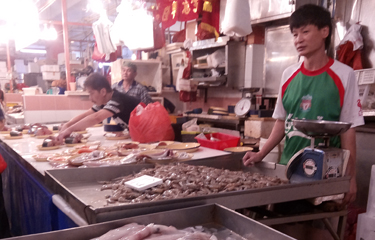Long a proponent of sourcing more seafood from overseas, China’s central government has shifted its strategy in response to pressures related to COVID-19.
China continues to encourage seafood imports, which have long been seen as a means of dampening consumer price inflation. Recently, China reduced the tariff on frozen cod from 7 percent to 2 percent, while duties on ribbonfish, frozen crab, and frozen small shrimp were also reduced from 7 percent to 5 percent. The rate on live or fresh abalone imports dropped from 10 percent to 7 percent. The biggest cut was for “fertilized fish eggs,” which went from 12 to zero percent. Chinese import taxes for most seafood range from 5 percent to 7 percent, while VAT is charged at 9 percent.
But disruptions to national distribution channels, fears over COVID-19 spreading via imported seafood, and aggressive political posturing on the global stage have accelerated a shift in China’s strategy of making consumption the country’s key economic driver and replacing a dependency on imports with local alternatives.
The Chinese government’s efforts to support seafood suppliers making this shift have been two-pronged. First, it has offered assistance with marketing and brand-building, as well as training programs delivered through the China Fishery Academy and the Ocean and Fisheries Bureau. Second, China has in effect made foreign access to its market more difficult in order to cajole and facilitate local seafood firms to shift focus into the hungry domestic market.
Didier Boon, head of Beijing-based East China Seas, said heavy-handed moves against seafood imports by Chinese authorities have been partly motivated by a wish to substitute imports while making local producers less dependent on export markets.
“Making it difficult for shrimp importers means there is not enough shrimps in the market and companies sell in the local market at higher prices,” Boon told SeafoodSource. “It helps factories and develops the local market, which is exactly what the government wants [to] increase the GDP from internal business and rely less on international trade.”
Controls at Chinese ports for COVID-19 detection – packaging on each shipment is tested with nucleic acid, and a positive test results in a one-week shutdown of all import activity – have been a deterrent for importers, Boon said, adding that a global shipping container shortage has exacerbated trading recalcitrance.
“Importers are still wary to import, as they may lose the containers,” he said. “This is true for vannamei imports from Ecuador for local market and for the many containers from India and similar that are for reprocessing in China and re-export.”
Indian exporters have had especially acute difficulties accessing China. Clearance of containers at Chinese ports has been a “problem,” according to Dileep Kumar, head of Kerala, India-based based ESeafood Exports. Faced with the potential of failing a COVID check at a Chinese port, Indian exporters have switched supply of vannemei and other products to Middle Eastern markets, Kumar said.
“There is no problem with demand in China, and our old customers still buy, but we haven’t had many new inquiries from China recently,” he told SeafoodSource.
Fan Xubing, head of Seabridge, a Beijing-based marketing consultancy with foreign seafood exporter clients, said domestic seafood producers have benefitted from that disruption in trade.
“Imported seafood was seriously affected by COVID-19 in China and most species market were shrinking [in 2020]. But sales of domestic seafood, especially farmed seafood, are growing very well,” Fan said.
Overall, Chinese seafood imports dropped by 20 percent last year. But Fan said products that aren’t produced in China at the volumes required to meet demand are still finding favor in the Chinese marketplace. Species such as coldwater shrimp from Canada and Greenland, live North American lobster, and live king crab from Russia were “almost not affected by COVID-19,” according to Fan.
Coldwater shrimp – of which the global catch is only about 250,000 tons a year – benefits from a perception in China of boasting better food safety values, Fan told SeafoodSource. Similarly, Chilean sea bass has become popular as a baby supplementary food. And live spiny lobster from New Zealand has filled a niche resulting from China’s ban on Australian live spiny lobster.
While local production of shrimp is increasingly being diverted to domestic consumption, the country’s demand for salmon is rising far faster than its domestic production. As a result, China may be adopting a more liberalized approach to its salmon imports, actively pursuing a free trade deal with Norway, the world’s leading salmon producer.
“Improved market access to China through reduced tariff will be a positive for the Norwegian seafood companies in general, versus competing regions like Chile,” Alexander Aukner, who covers the salmon sector for Norwegian investment bank DNB, told SeafoodSource. “It is hard to speculate on such timing, but salmon supply from Chile, China’s other large supplier, is expected to drop materially in 2021, so would be advantageous to get the deal done so they have access to cheaper salmon from Norway.”
The ability of China to shift decisively away from exports to domestic consumption remains in question. There is some anxiety among investors over the outlook for China’s economy for the rest of the year, as government withdraws stimulus and clamps down on loose credit and unregulated credit platforms. China’s benchmark stock market index, the CSI300, dropped 15 percent from its mid-February peak in mid-April. After a long rising run, the renminbi has fallen 1.4 percent to CNY 6.57 to the U.S. dollar as investors look to a U.S. economic recovery. It may be that seafood firms need export earnings for a little longer. Meanwhile, importers facing difficulties shipping into China may start to look elsewhere for sales.
Photo courtesy of Mark Godfrey/SeafoodSource







